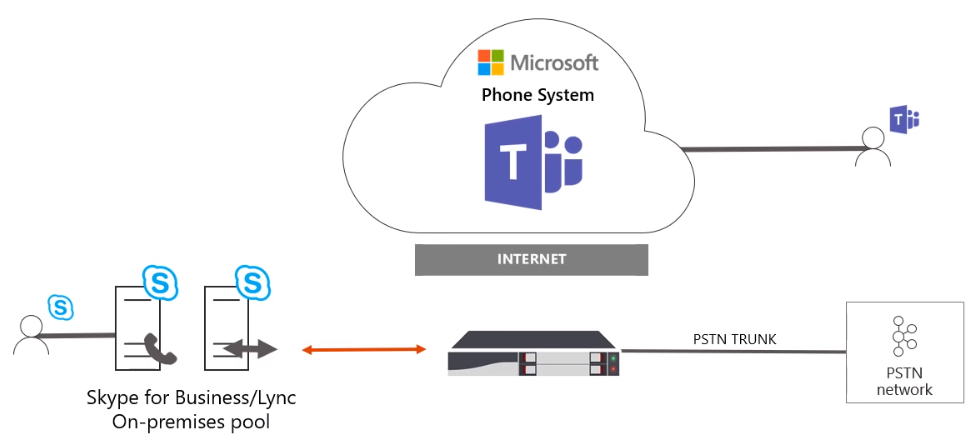Welcome back to the last blog in this series! In part 4 of this series, we talked about the SIP syntax, user provisioning, and voice routing scenarios for Direct Routing. This time we’ll discuss how to migrate from Cloud PBX with Skype for Business clients either utilizing on-premises Lync or Skype for Business Server.
Path to the cloud from Skype for Business on-premises with own trunks
As you will see in the picture below, we have an SBC that is being utilized with our existing Skype for Business or Lync on-premises pool. You will also notice that the SBC has a PSTN connection through an existing service provider.
 Assuming the SBC is a Microsoft certified SBC (AudioCodes, Ribbon, etc.) you can pair this in parallel to the Microsoft Teams O365 Direct Routing environment. This would allow us to leverage the SBC for the on-premises Skype for Business environment as well as the online O365 Phone System environment. Inbound routing for Skype for Business users would remain unchanged by hitting the SBC and then route over to the Skype for Business user. However, once the SBC has been paired to the Teams environment, you can then also route calls from the PSTN network into the cloud for the users that are utilizing Microsoft Teams. As users are migrated from your on-premises Skype for Business environment into Teams in the cloud, once all users have been successfully migrated you will be able to decommission your Skype for Business on-premises environment. This will then allow you to continue to leverage the existing SBC that is already in play by swinging the users over from Skype for Business on-premises to Teams with Direct Routing.
Assuming the SBC is a Microsoft certified SBC (AudioCodes, Ribbon, etc.) you can pair this in parallel to the Microsoft Teams O365 Direct Routing environment. This would allow us to leverage the SBC for the on-premises Skype for Business environment as well as the online O365 Phone System environment. Inbound routing for Skype for Business users would remain unchanged by hitting the SBC and then route over to the Skype for Business user. However, once the SBC has been paired to the Teams environment, you can then also route calls from the PSTN network into the cloud for the users that are utilizing Microsoft Teams. As users are migrated from your on-premises Skype for Business environment into Teams in the cloud, once all users have been successfully migrated you will be able to decommission your Skype for Business on-premises environment. This will then allow you to continue to leverage the existing SBC that is already in play by swinging the users over from Skype for Business on-premises to Teams with Direct Routing.
Path to cloud from Skype for Business Online with own trunks
Another scenario that you may find is if a user is the Skype for Business user is homed in O365 and utilizing Skype for Business Online. As you will see in the picture below, this user interconnects to the PSTN either via Cloud Connector Edition (CCE) or through an existing on-premises deployment which is often referred to as OPCH (On-Premises Connectivity Hybrid) to allow the Skype for Business Online user to make/receive phone calls.
Assuming that the SBC is a certified SBC as mentioned earlier, you’ll have the ability to pair the SBC in parallel to O365. You would reconfigure the SBC to connect to the Teams Direct Routing infrastructure. You can then migrate your users from Skype for Business Online to Teams. Then you will reconfigure their routing such that they will utilize the new voice routes that include Direct Routing. Finally, you would decommission your Skype for Business infrastructure once your migration is complete.
This concludes the blog series on Direct Routing. I hope you have found this helpful and I encourage you to go look at the official blog post regarding Direct Routing being released for General Availability (GA).


